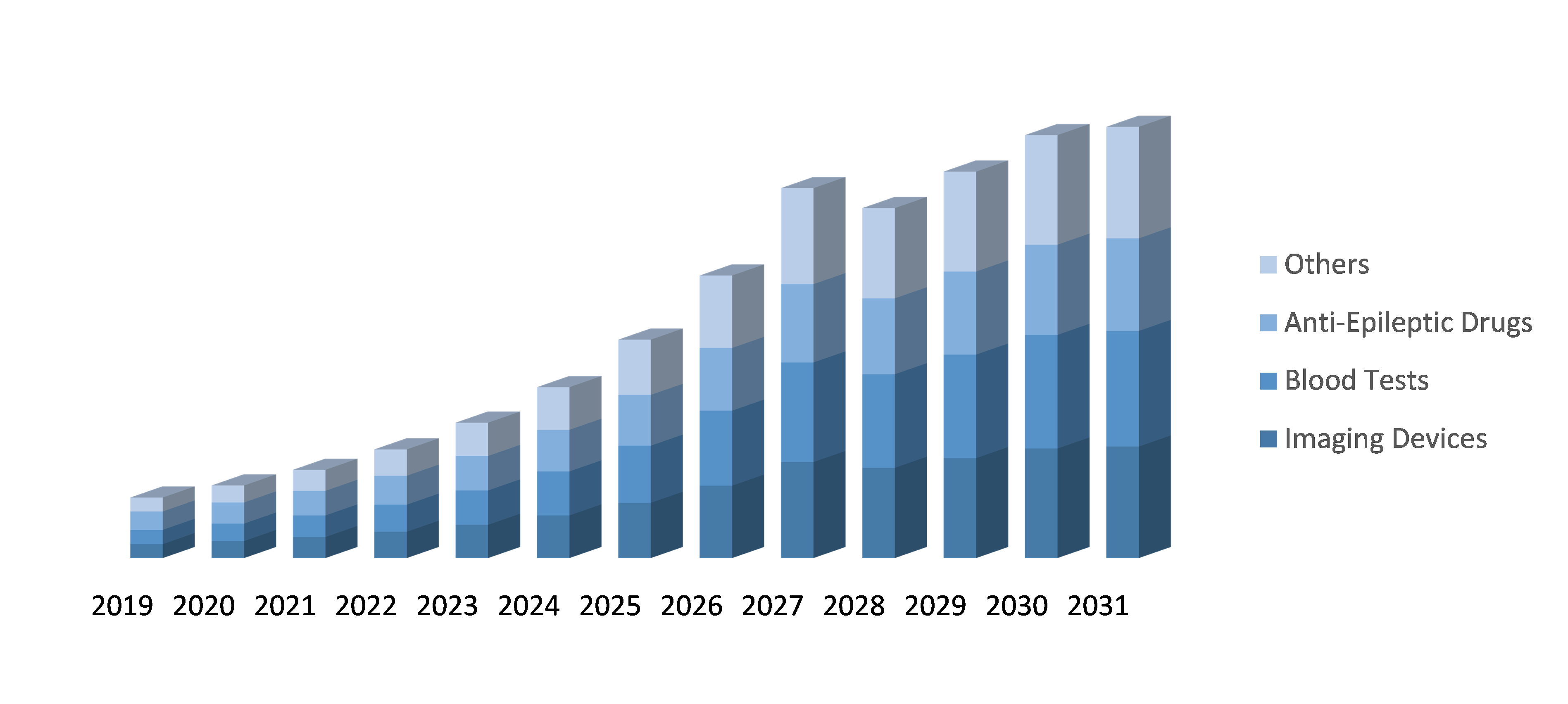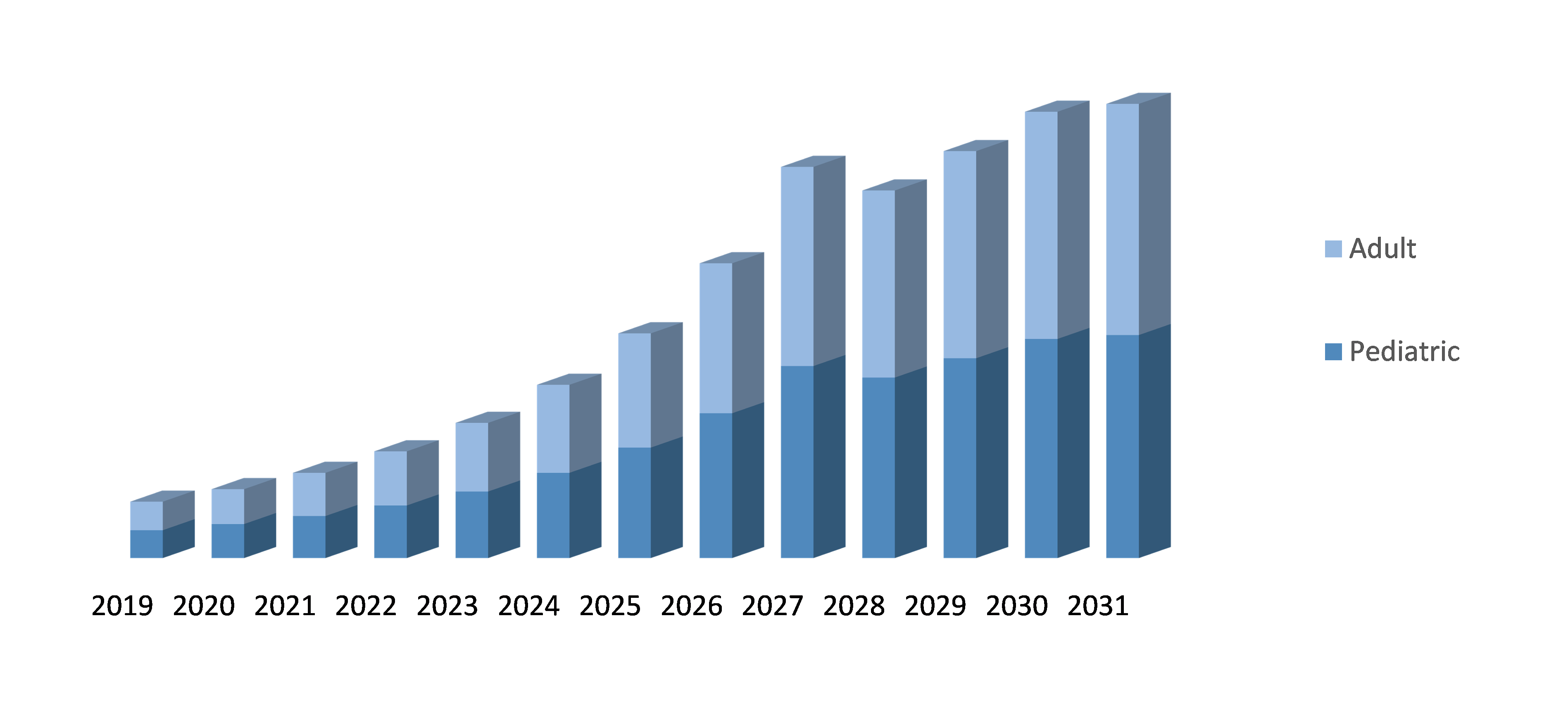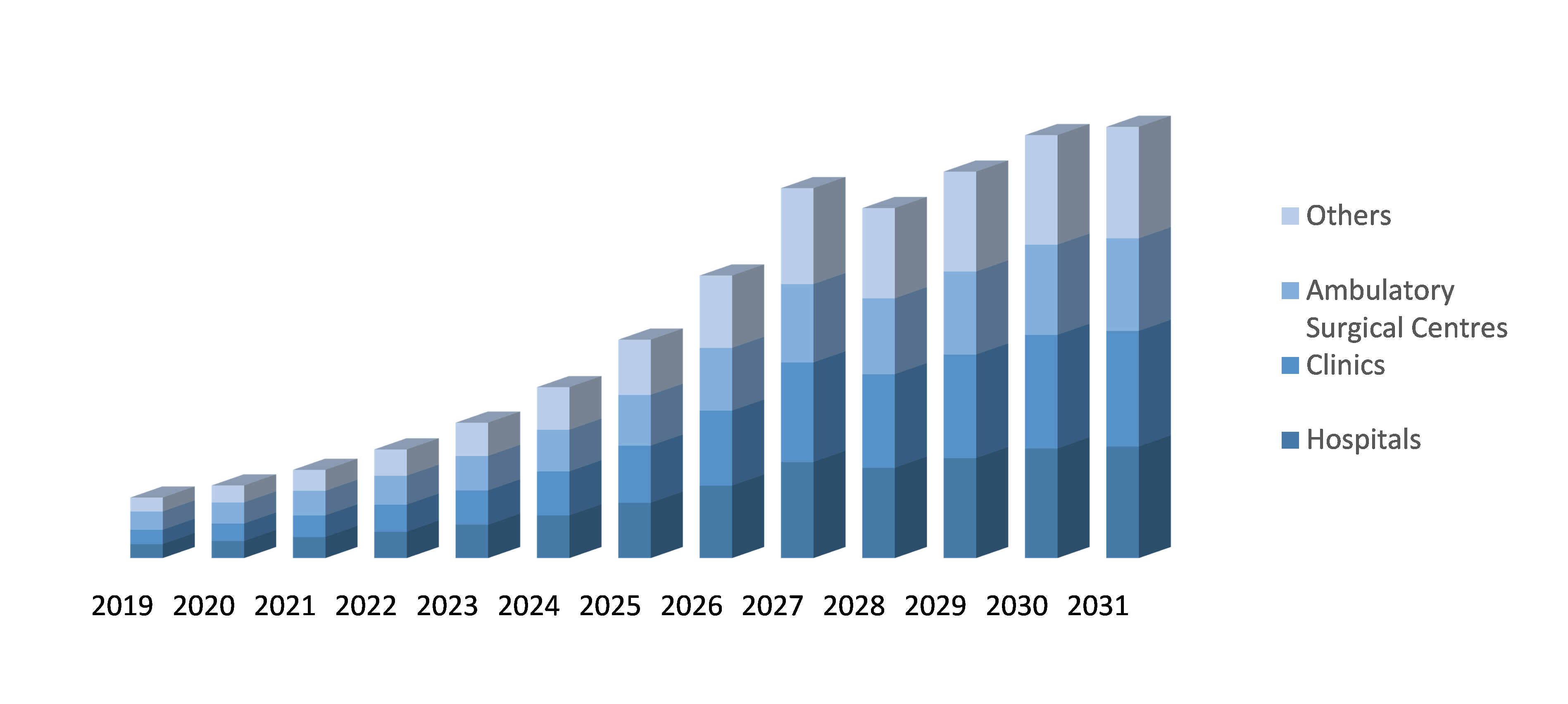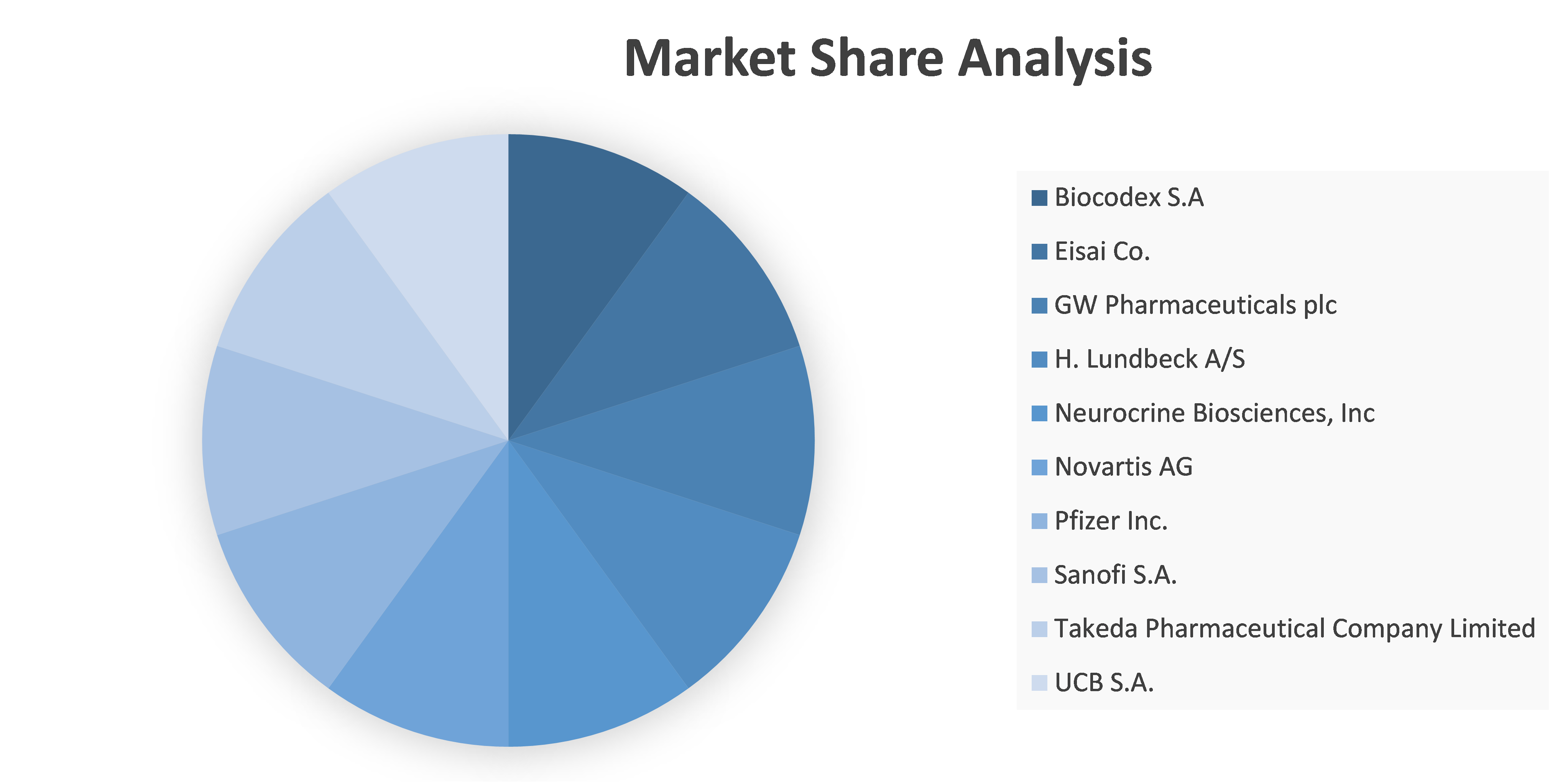- Home
- Rare Epilepsies Market

Rare epilepsies Market by Diagnosis and Treatment (Imaging Devices, Blood Tests, Anti-Epileptic Drugs, Others), by Age (Pediatric and Adult) by End-User (Hospitals, Clinics, Ambulatory Surgical Centres and Others): Global Opportunity Analysis and Industry Forecast, 2022-2032
- Published Date: March, 2023 | Report ID: CLS-1921 | No of pages: 250 | Format:

The Rare epilepsies market was valued at $XX million in 2022. It is projected to grow at a CAGR of 6.2% from 2023 to 2031 and reach more than XX million by the end of 2031.
Analysts’ Viewpoint
The market for rare epilepsies is expected to grow in the coming years due to an increasing prevalence of these conditions and a growing demand for effective treatment options. Rare epilepsies, which are defined as epilepsies that affect fewer than 200,000 people in the United States, are a heterogeneous group of disorders that are often difficult to diagnose and treat.
Additionally, the report highlights the emergence of novel therapies that target specific genetic mutations and biochemical pathways underlying rare epilepsies as a key factor contributing to market growth. For example, the approval of Fintepla (fenfluramine) for the treatment of Dravet syndrome, a rare form of epilepsy, in the United States and Europe has generated significant interest in the development of targeted therapies for rare epilepsies.
Furthermore, initiatives such as the Rare Epilepsy Network, which aims to improve the diagnosis and treatment of rare epilepsies, are expected to increase awareness and understanding of these conditions among healthcare professionals and the general public, which could further drive market growth.
Rare epilepsies Overview
Epilepsy is a neurological disorder that affects millions of people worldwide, but some forms of epilepsy are considered rare due to their low prevalence. Rare epilepsies are those that occur in fewer than 1 in 2,000 individuals. These forms of epilepsy can be difficult to diagnose and treat due to their rarity, and they may require specialized medical care.
One example of a rare epilepsy is Dravet syndrome. This is a severe form of epilepsy that usually begins in infancy and is associated with developmental delays and cognitive impairment. It is caused by genetic mutations that affect the function of sodium channels in the brain. The prevalence of Dravet syndrome is estimated to be around 1 in 15,700 to 20,000 individuals. Another rare epilepsy is Lennox-Gastaut syndrome. This is a childhood-onset epilepsy that is characterized by multiple types of seizures, cognitive impairment, and behavioral problems. The prevalence of Lennox-Gastaut syndrome is estimated to be around 1 in 1,000 to 2,000 individuals.
Another rare form of epilepsy is Rett syndrome. This is a neurodevelopmental disorder that primarily affects girls and is caused by mutations in the MECP2 gene. Rett syndrome is characterized by a regression of skills and abilities, seizures, and cognitive impairment. The prevalence of Rett syndrome is estimated to be around 1 in 10,000 to 15,000 individuals. In conclusion, rare epilepsies are a group of neurological disorders that are less common than other forms of epilepsy. They can be challenging to diagnose and treat, and they may require specialized medical care. It is essential to raise awareness about these rare forms of epilepsy to improve understanding and management of these conditions.
The development of new diagnostic tools and technologies has revolutionized the diagnosis and treatment of rare epilepsies. Advances in neuroimaging, genetics, and other diagnostic technologies have improved the accuracy and speed of diagnosis, enabling healthcare providers to better understand these complex disorders. One example of a diagnostic tool that has transformed the diagnosis of rare epilepsies is genetic testing. Many rare epilepsies are caused by genetic mutations, and genetic testing can identify the specific mutations responsible for a patient's condition. This allows for personalized treatment plans and helps to identify potential carriers of the mutation, allowing for early intervention in family members who may be at risk.
Neuroimaging technologies such as magnetic resonance imaging (MRI) and positron emission tomography (PET) have also improved the diagnosis of rare epilepsies. These imaging technologies allow for detailed visualization of the brain, enabling healthcare providers to identify structural abnormalities or areas of abnormal brain activity that may be responsible for seizures.
The development of new treatments for rare epilepsies presents a significant opportunity for pharmaceutical companies to bring novel therapies to market. Currently, there are few approved treatments for many rare epilepsies, leaving patients with limited options for managing their symptoms. One example of a new treatment for rare epilepsies is cannabidiol (CBD), a compound derived from the cannabis plant. In 2018, the US Food and Drug Administration (FDA) approved the use of a CBD-based medication called Epidiolex for the treatment of two rare forms of epilepsy, Lennox-Gastaut syndrome and Dravet syndrome. This approval marked a significant milestone in the development of new treatments for rare epilepsies.
Other promising areas of research for new treatments for rare epilepsies include gene therapy and small molecule drugs that target specific genetic mutations or pathways involved in seizure activity. For example, some researchers are investigating the use of gene therapy to deliver therapeutic genes to brain cells, potentially restoring normal brain activity and reducing seizures in patients with certain rare epilepsies.
New product launches to flourish in the market
In 2020, the FDA approved Valtoco for the treatment of cluster seizures, a rare type of seizure disorder that can be difficult to treat. Valtoco is a nasal spray formulation of diazepam, a medication commonly used to treat seizures. This new formulation provides a faster and more convenient way to administer diazepam during a seizure emergency. In 2019, the FDA approved Fintepla for the treatment of Dravet syndrome, a rare form of epilepsy that typically begins in infancy. Fintepla works by increasing levels of serotonin in the brain, which can help to reduce seizure activity. This approval marked an important milestone in the development of new treatments for rare epilepsies.
Segment Overview:
By Diagnosis and Treatment: The Rare epilepsies market is divided into Imaging Devices, Blood Tests, Anti-Epileptic Drugs, and Others. The rare epilepsies market can be segmented based on diagnosis and treatment options. Imaging devices, such as MRI and CT scans, are used to diagnose rare epilepsies by creating images of the brain. Blood tests can also be used to diagnose certain types of rare epilepsies, such as autoimmune epilepsy. Anti-epileptic drugs (AEDs) are the mainstay of treatment for rare epilepsies, and new AEDs are continually being developed. Other treatment options include surgery, dietary therapies, and medical devices, such as vagus nerve stimulators. The diverse range of diagnostic and treatment options in the rare epilepsies market highlights the complexity of these conditions and the need for personalized treatment approaches.
 By Age: The rare epilepsies market is segmented by age, with pediatric and adult populations being the main categories. Pediatric epilepsies refer to those that occur in children under the age of 18, while adult epilepsies refer to those that occur in individuals over the age of 18. The prevalence and etiology of rare epilepsies may differ between these two age groups, highlighting the need for age-specific diagnostic and treatment approaches. For example, some rare epilepsies are more commonly diagnosed in childhood, such as Lennox-Gastaut syndrome, while others may have a later onset, such as autoimmune epilepsy. Understanding the age-specific characteristics of rare epilepsies is crucial for improving diagnosis, treatment, and overall outcomes for patients.
By Age: The rare epilepsies market is segmented by age, with pediatric and adult populations being the main categories. Pediatric epilepsies refer to those that occur in children under the age of 18, while adult epilepsies refer to those that occur in individuals over the age of 18. The prevalence and etiology of rare epilepsies may differ between these two age groups, highlighting the need for age-specific diagnostic and treatment approaches. For example, some rare epilepsies are more commonly diagnosed in childhood, such as Lennox-Gastaut syndrome, while others may have a later onset, such as autoimmune epilepsy. Understanding the age-specific characteristics of rare epilepsies is crucial for improving diagnosis, treatment, and overall outcomes for patients.
 By End-user: The Rare epilepsies market is divided into Hospitals, Clinics, Ambulatory Surgical Centres and Others. Hospitals provide specialized care for patients with various medical conditions, including rare epilepsies. Hospitals may have specialized epilepsy centers that offer comprehensive evaluation, diagnosis, and treatment options for patients with rare epilepsies. Clinics are outpatient facilities that provide medical care for patients with a range of conditions, including epilepsy. Epilepsy clinics may offer diagnostic services, medication management, and other treatments for patients with rare epilepsies. Ambulatory Surgical Centers are outpatient facilities that specialize in providing surgical services to patients. Others may include other healthcare settings that provide care for patients with rare epilepsies, such as rehabilitation centers, long-term care facilities, or home healthcare services.
By End-user: The Rare epilepsies market is divided into Hospitals, Clinics, Ambulatory Surgical Centres and Others. Hospitals provide specialized care for patients with various medical conditions, including rare epilepsies. Hospitals may have specialized epilepsy centers that offer comprehensive evaluation, diagnosis, and treatment options for patients with rare epilepsies. Clinics are outpatient facilities that provide medical care for patients with a range of conditions, including epilepsy. Epilepsy clinics may offer diagnostic services, medication management, and other treatments for patients with rare epilepsies. Ambulatory Surgical Centers are outpatient facilities that specialize in providing surgical services to patients. Others may include other healthcare settings that provide care for patients with rare epilepsies, such as rehabilitation centers, long-term care facilities, or home healthcare services.

By Region: The Asia Pacific (APAC) rare epilepsies market is experiencing significant growth due to several factors. Firstly, there is an increasing awareness of rare epilepsies in the region, leading to more diagnoses and demand for treatments. Additionally, the growing prevalence of rare epilepsies in APAC countries, particularly in India and China, is driving market growth. The rising healthcare expenditure and improving healthcare infrastructure in these countries are also contributing to the growth of the rare epilepsies market. Furthermore, the increasing focus on research and development of new treatments for rare epilepsies in APAC countries is expected to further drive market growth. Overall, the APAC rare epilepsies market is poised for substantial growth in the coming years, presenting opportunities for pharmaceutical companies to bring novel treatments to market and improve patient outcomes in the region.

Competitive analysis and profiles of the major players in the rare epilepsies market, such as Biocodex S.A., Eisai Co., Ltd., GW Pharmaceuticals plc., H. Lundbeck A/S, Neurocrine Biosciences, Inc., Novartis AG, Pfizer Inc., Sanofi S.A., Takeda Pharmaceutical Company Limited and UCB S.A. Major players have adopted product launch and acquisition as key developmental strategies to improve the product portfolio of the Rare epilepsies market.
Market Scope and Structure Analysis
|
Report Metric |
Details |
|
Market Size Available for Years |
2021–2031 |
|
Base Year Considered |
2022 |
|
Forecast Period |
2023–2031 |
|
Forecast Unit |
Value (USD) |
|
Segments Covered |
By Diagnosis and Treatment, By Age, End-user, and Region |
|
Regions Covered |
North America, Europe, Asia-Pacific, LAMEA |
|
Companies Covered |
Biocodex S.A., Eisai Co., Ltd., GW Pharmaceuticals plc., H. Lundbeck A/S, Neurocrine Biosciences, Inc., Novartis AG, Pfizer Inc., Sanofi S.A., Takeda Pharmaceutical Company Limited and UCB S.A. |
Key Segments Covered
Diagnosis and Treatment
- Imaging Devices
- Blood Tests
- Anti-Epileptic Drugs
- Others
Age
- Pediatric
- Adult
End-user
- Hospitals
- Clinics
- Ambulatory Surgical Centres
- Others
Region
- North America
- U.S.
- Canada
- Mexico
- Europe
- Germany
- UK
- France
- Italy
- Spain
- Rest of Europe
- Asia-Pacific
- China
- Japan
- South Korea
- India
- Australia
- Rest of Asia-Pacific
- LAMEA
- Latin America
- Middle East
- Africa
TABLE OF CONTENT
- Research Methodology
- Desk Research
- Real time insights and validation
- Forecast model
- Assumptions and forecast parameters
- Assumptions
- Forecast parameters
- Data sources
- Primary
- Secondary
- Executive Summary
- 360° summary
- By Diagnosis and Treatment trends
- By Age trends
- By End-User trends
- Market Overview
- Market segmentation & definitions
- Key takeaways
- Top investment pockets
- Top winning strategies
- Porter’s five forces analysis
- Bargaining power of consumers
- Bargaining power of suppliers
- Threat of new entrants
- Threat of substitutes
- Competitive rivalry in the market
- Market dynamics
- Drivers
- Restraints
- Opportunities
- Technology landscape
- Regulatory landscape
- Patent landscape
- Market value chain analysis
- Strategic overview
- Rare Epilepsies Market, by Diagnosis and Treatment
- Imaging Devices
- Market size and forecast, by region, 2022-2031
- Comparative market share analysis, 2022 & 2031
- Blood Tests
- Market size and forecast, by region, 2022-2031
- Comparative market share analysis, 2022 & 2031
- Anti-Epileptic Drugs
- Market size and forecast, by region, 2022-2031
- Comparative market share analysis, 2022 & 2031
- Others
- Market size and forecast, by region, 2022-2031
- Comparative market share analysis, 2022 & 2031
- Imaging Devices
- Rare Epilepsies Market, by Age
- Pediatric
- Market size and forecast, by region, 2022-2031
- Comparative market share analysis, 2022 & 2031
- Adult
- Market size and forecast, by region, 2022-2031
- Comparative market share analysis, 2022 & 2031
- Pediatric
- Rare Epilepsies Market, by End-User
- Hospitals
- Market size and forecast, by region, 2022-2031
- Comparative market share analysis, 2022 & 2031
- Clinics
- Market size and forecast, by region, 2022-2031
- Comparative market share analysis, 2022 & 2031
- Ambulatory Surgical Centres
- Market size and forecast, by region, 2022-2031
- Comparative market share analysis, 2022 & 2031
- Others
- Market size and forecast, by region, 2022-2031
- Comparative market share analysis, 2022 & 2031
- Hospitals
- Rare Epilepsies Market, by Region
- North America
- Market size and forecast, by Diagnosis and Treatment, 2022-2031
- Market size and forecast, by Age, 2022-2031
- Market size and forecast, by End-User, 2022-2031
- Market size and forecast, by country, 2022-2031
- Comparative market share analysis, 2022 & 2031
- U.S.
- Market size and forecast, by Diagnosis and Treatment, 2022-2031
- Market size and forecast, by Age, 2022-2031
- Market size and forecast, by End-User , 2022-2031
- Comparative market share analysis, 2022 & 2031
- Canada
- Market size and forecast, by Diagnosis and Treatment, 2022-2031
- Market size and forecast, by Age, 2022-2031
- Market size and forecast, by End-User , 2022-2031
- Comparative market share analysis, 2022 & 2031
- Mexico
- Market size and forecast, by Diagnosis and Treatment, 2022-2031
- Market size and forecast, by Age, 2022-2031
- Market size and forecast, by End-User , 2022-2031
- Comparative market share analysis, 2022 & 2031
- Europe
- Market size and forecast, by Diagnosis and Treatment, 2022-2031
- Market size and forecast, by Age, 2022-2031
- Market size and forecast, by End-User , 2022-2031
- Market size and forecast, by country, 2022-2031
- Comparative market share analysis, 2022 & 2031
- Germany
- Market size and forecast, by Diagnosis and Treatment, 2022-2031
- Market size and forecast, by Age, 2022-2031
- Market size and forecast, by End-User , 2022-2031
- Comparative market share analysis, 2022 & 2031
- UK
- Market size and forecast, by Diagnosis and Treatment, 2022-2031
- Market size and forecast, by Age, 2022-2031
- Market size and forecast, by End-User , 2022-2031
- Comparative market share analysis, 2022 & 2031
- France
- Market size and forecast, by Diagnosis and Treatment, 2022-2031
- Market size and forecast, by Age, 2022-2031
- Market size and forecast, by End-User , 2022-2031
- Comparative market share analysis, 2022 & 2031
- Spain
- Market size and forecast, by Diagnosis and Treatment, 2022-2031
- Market size and forecast, by Age, 2022-2031
- Market size and forecast, by End-User , 2022-2031
- Comparative market share analysis, 2022 & 2031
- Italy
- Market size and forecast, by Diagnosis and Treatment, 2022-2031
- Market size and forecast, by Age, 2022-2031
- Market size and forecast, by End-User , 2022-2031
- Comparative market share analysis, 2022 & 2031
- North America
-
-
- Rest of Europe
- Market size and forecast, by Diagnosis and Treatment, 2022-2031
- Market size and forecast, by Age, 2022-2031
- Market size and forecast, by End-User , 2022-2031
- Comparative market share analysis, 2022 & 2031
- Rest of Europe
- Asia Pacific
- Market size and forecast, by Diagnosis and Treatment, 2022-2031
- Market size and forecast, by Age, 2022-2031
- Market size and forecast, by End-User , 2022-2031
- Market size and forecast, by country, 2022-2031
- Comparative market share analysis, 2022 & 2031
- China
- Market size and forecast, by Diagnosis and Treatment, 2022-2031
- Market size and forecast, by Age, 2022-2031
- Market size and forecast, by End-User , 2022-2031
- Comparative market share analysis, 2022 & 2031
- India
- Market size and forecast, by Diagnosis and Treatment, 2022-2031
- Market size and forecast, by Age, 2022-2031
- Market size and forecast, by End-User , 2022-2031
- Comparative market share analysis, 2022 & 2031
- Australia
- Market size and forecast, by Diagnosis and Treatment, 2022-2031
- Market size and forecast, by Age, 2022-2031
- Market size and forecast, by End-User , 2022-2031
- Comparative market share analysis, 2022 & 2031
- Rest of Asia Pacific
- Market size and forecast, by Diagnosis and Treatment, 2022-2031
- Market size and forecast, by Age, 2022-2031
- Market size and forecast, by End-User , 2022-2031
- Comparative market share analysis, 2022 & 2031
- LAMEA
- Market size and forecast, by Diagnosis and Treatment, 2022-2031
- Market size and forecast, by Age, 2022-2031
- Market size and forecast, by End-User , 2022-2031
- Market size and forecast, by country, 2022-2031
- Comparative market share analysis, 2022 & 2031
- Latin America
- Market size and forecast, by Diagnosis and Treatment, 2022-2031
- Market size and forecast, by Age, 2022-2031
- Market size and forecast, by End-User , 2022-2031
- Comparative market share analysis, 2022 & 2031
- Middle East
- Market size and forecast, by Diagnosis and Treatment, 2022-2031
- Market size and forecast, by Age, 2022-2031
- Market size and forecast, by End-User , 2022-2031
- Comparative market share analysis, 2022 & 2031
- Africa
- Market size and forecast, by Diagnosis and Treatment, 2022-2031
- Market size and forecast, by Age, 2022-2031
- Market size and forecast, by End-User , 2022-2031
- Comparative market share analysis, 2022 & 2031
-
- Company profiles
- Biocodex S.A.
- Business overview
- Financial performance
- Diagnosis and Treatment portfolio
- Recent strategic moves & developments
- SWOT analysis
- Eisai Co., Ltd.
- Business overview
- Financial performance
- Diagnosis and Treatment portfolio
- Recent strategic moves & developments
- SWOT analysis
- GW Pharmaceuticals plc.
- Business overview
- Financial performance
- Diagnosis and Treatment portfolio
- Recent strategic moves & developments
- SWOT analysis
- H. Lundbeck A/S
- Business overview
- Financial performance
- Diagnosis and Treatment portfolio
- Recent strategic moves & developments
- SWOT analysis
- Neurocrine Biosciences
- Business overview
- Financial performance
- Diagnosis and Treatment portfolio
- Recent strategic moves & developments
- SWOT analysis
- Novartis AG
- Business overview
- Financial performance
- Diagnosis and Treatment portfolio
- Recent strategic moves & developments
- SWOT analysis
- Pfizer Inc.
- Business overview
- Financial performance
- Diagnosis and Treatment portfolio
- Recent strategic moves & developments
- SWOT analysis
- Sanofi S.A
- Business overview
- Financial performance
- Diagnosis and Treatment portfolio
- Recent strategic moves & developments
- SWOT analysis
- Takeda Pharmaceutical Company Limited
- Business overview
- Financial performance
- Diagnosis and Treatment portfolio
- Recent strategic moves & developments
- SWOT analysis
- UCB S.A.
- Business overview
- Financial performance
- Diagnosis and Treatment portfolio
- Recent strategic moves & developments
- SWOT analysis
- Biocodex S.A.
Segmentation
Key Segments Covered
Diagnosis and Treatment
- Imaging Devices
- Blood Tests
- Anti-Epileptic Drugs
- Others
Age
- Pediatric
- Adult
End-user
- Hospitals
- Clinics
- Ambulatory Surgical Centres
- Others
Region
- North America
- U.S.
- Canada
- Mexico
- Europe
- Germany
- UK
- France
- Italy
- Spain
- Rest of Europe
- Asia-Pacific
- China
- Japan
- South Korea
- India
- Australia
- Rest of Asia-Pacific
- LAMEA
- Latin America
- Middle East
- Africa
Methodology
Get your pre and post sales queries resolved by our Subject matter experts.
We will assist you to customize the report to fit your research needs.
Our prime focus is to provide qualitative and accurate data.
Feel free to order a sample report before purchase.
Your personal and confidential information is safe and secured.
© 2025 Cognate Lifesciences. All Rights Reserved.
